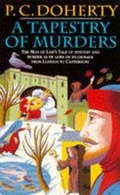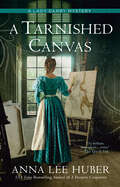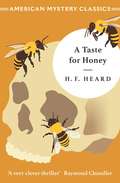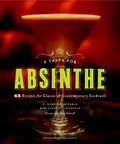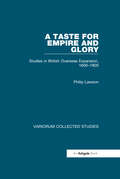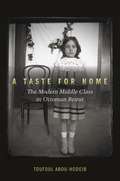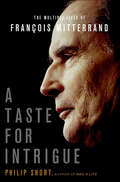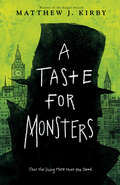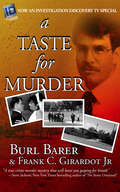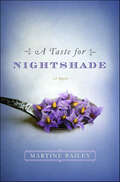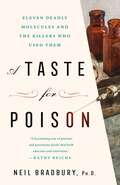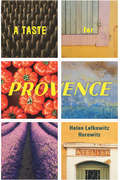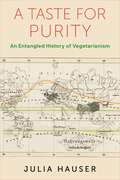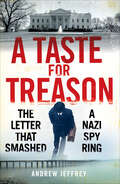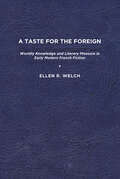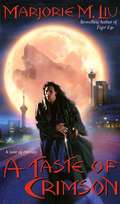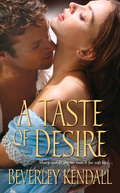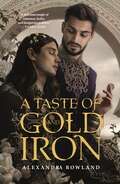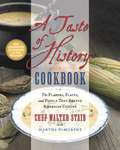- Table View
- List View
A Tapestry of Murders (Canterbury Tales Mysteries, Book 2): Terror and intrigue in medieval England
by Paul DohertyEven death cannot stop her...Paul Doherty relates the Man of Law's tale in A Tapestry of Murders - a tale of mystery and murder as he goes on pilgrimage from London to Canterbury. Perfect for fans of Ellis Peters and Susanna Gregory.Chaucer's pilgrims, quarrelling amongst themselves, are now in open countryside enjoying the fresh spring weather as they progress slowly towards Canterbury. A motley collection of travellers, they each have their dark secrets, hidden passions and complex lives. As they shelter in a tavern from a sudden April shower they choose the Man of Law to narrate the next tale of fear and sinister dealings.In August 1358, the Dowager Queen Isabella, mother of King Edward III, the 'She Wolf of France', who betrayed and destroyed her husband because of her adulterous infatuation for Roger Mortimer, lies dying of the pestilence in the sombre fortress of Castle Rising, where her 'loving' son has kept her incarcerated. According to the Man of Law, Isabella dies and her body is taken along the Mile End Road and laid to rest in Greyfriars next to the mangled remains of her lover, who has paid dearly for his presumption in loving a queen. Nevertheless, as in life so in death Isabella causes intrigue, violence and murder. Nicholas Chirke, an honest young lawyer, is brought in to investigate the strange events following her death - and quickly finds himself at his wits' end trying to resolve the mysteries before a great scandal unfolds.What readers are saying about Canterbury Tales Mysteries:'Doherty does it again. Another gripping yarn in the Canterbury series. Each in the series has its own twists''You can almost feel yourself there''Spellbinding'
A Tapestry of Murders: Terror and intrigue in medieval England (Canterbury Tales Mysteries #2)
by Paul DohertyThe Man of Law's Tale of terror and intrigue in the Canterbury Tales seriess Chirke, an honest young lawyer, is brought in to investigate the strange events following her death - and quickly finds himself at his wits' end trying to resolve the mysteries before a great scandal unfolds.
A Tapestry of Murders: The Lawyer's Tale of Mystery and Murder as He Goes on Pilgrimage from London to Canterbury (Canterbury Tales of Mystery and Murder #2)
by P. C. DohertyChaucer's pilgrims, quarrelling amongst themselves, are now in open countryside enjoying the fresh spring weather as they progress slowly towards Canterbury. A motley collection of travellers, they each have their dark secrets, hidden passions and complex lives. As they shelter in a tavern from a sudden April shower they choose the Man of Law to follow the Knight and narrate the evening tale of fear and sinister dealings. In August 1358, the Dowager Queen Isabella, mother of King Edward III, the 'She Wolf of France', who betrayed and destroyed her husband because of her adulterous infatuation for Roger Mortimer, lies dying of the pestilence in the sombre fortress of Castle Rising, where her 'loving' son has kept her incarcerated. According to the Man of Law, Isabella dies and her body is taken along the Mile End Road and laid to rest in Greyfriars next to the mangled remains of her lover, who has paid dearly for his presumption in loving a queen. Nevertheless, as in life so in death Isabella causes intrigue, violence and murder. On the day of Isabella's burial her trusted squire attempts to flee, carrying, it is believed by the authorities, a manuscript that could discredit the English king. But, captured and grievously wounded, he dies before revealing his secrets to the man commanded to discover them, Sir Stephen Berrisford. Berrisford himself is then found murdered in perplexing circumstances. Nicholas Chirke, an honest young lawyer, is brought in to investigate - and quickly finds himself at his wits' end trying to resolve the mysteries before a great scandal unfolds. The Man of Law's Tale is a medieval murder mystery based on hard fact; with a gallery of the good, the bad and the evil, it is set against the violent backdrop of medieval London and its sinister underworld.
A Tarnished Canvas (A Lady Darby Mystery)
by Anna Lee HuberLady Kiera Darby had planned to spend the winter practicing her painting, but instead, she must find the flaw in a killer&’s masterpiece when an art auction results in one participant&’s final bid.…March 1833. Kiera and her husband, Sebastian Gage, have decided to settle in Edinburgh for the winter with their infant daughter. This also allows Kiera to enjoy long hours painting in her studio, making progress on the portraits she soon hopes to unveil in her own exhibit. She&’s thrilled when she receives an invitation to the auction of the late Lord Eldin&’s coveted art collection, and she and Gage eagerly accept. When the floor collapses beneath the gathering, killing one of their fellow bidders, Kiera and Gage are lucky to escape with their lives.Within days it becomes apparent that what at first seemed to be a terrible accident is actually something far more nefarious. Someone deliberately compromised the integrity of the structure, though the police are unsure of the culprit&’s aim. Sergeant Maclean requests Kiera and Gage&’s assistance in figuring out who would wish to harm the bidders. As they dig deeper, it becomes increasingly apparent that the victim was not the killer&’s intended target . . . and that Kiera was lured to the auction deliberately. Kiera and Gage must utilize all their resources to unveil a monster willing to risk the lives of dozens of bystanders to achieve their ends. But they&’re on the verge of making a dire miscalculation. For one of the cleverest tricks in a painter&’s repertoire is the art of misdirection, and their eyes have been drawn far from the gravest danger.
A Tarnished Eagle: Napoleon's Winter Campaign In Poland, December 1806 Through February 1807
by Major Edward J. MurphyThe victories and accomplishments of Napoleon and his Grand Army were by the winter of 1806, the stuff of legend. Yet, on the bloody field of Eylau, Napoleon lost both his prestige and over one third of his Army. How did this Russian Army of notable inferior weapons, tactics, organization and leadership stave off defeat and almost achieve victory? The answer lies in that Napoleon did not only fight the Russians, but also suffered a combination of poor morale and inaccurate reconnaissance. His overextended lines of communications covered an area that was known for its harsh terrain, poor supplies and extremely bad weather.The Campaign cost Napoleon over 43,000 casualties and proved indecisive. The campaign, and Battle of Eylau, ruined Napoleon's image of invincibility and completely gutted the Grand Army of a wealth of leadership and experience. Over twenty general officers were killed or seriously wounded at Eylau. Subsequently, Napoleon would have to consistently rely on more conscripts and an ever-increasing number of foreign troops to fill his depleted ranks. Napoleon's Army would never again resemble the previously invincible Grand Army that died on the blood-soaked snows of Poland.
A Taste For Honey
by H F HeardMycroft has turned detective...A masterclass of classic crime - 'A triumph of ingenuity and horrific simplicity' Boris Karloff'A very clever thriller' Raymond ChandlerIn an English country village, a recluse and a beekeeper team up to catch a cunning villain.Far from the noise of Victorian London, Sydney Silchester's two passions are privacy and honey. But when his honey supplier is found stung to death by her hive, the search for a new beekeeper takes Sydney to Mr. Mycroft, a brilliant man who has retired to Sussex to take up precisely this occupation, and who shares many traits with the great detective, Sherlock Holmes. Mycroft, himself no stranger to crime-solving, immediately senses the bloody hand of murder. But what villain would have the mad intelligence to train an army of killer bees? And will Mycroft risk his own life to find the killer?
A Taste For Scandal: A Sealed With a Kiss Novel
by Erin KnightleyThings have always fallen into place for Richard Moore, Earl of Raleigh. His good looks, abundance of charm, and the small matter of being heir to a marquisate make him quite the catch. <P><P>So when a delectable young woman wants nothing to do with him, he can't help but seize the irresistible challenge. AN UNLIKELY COURTSHIP Jane Bunting knows all about responsibility--she has managed to support herself and her brother with their bakery--but she knows nothing of excitement or passion. When dashing Lord Raleigh crosses the threshold of her shop, she has no idea of the potential danger to her reputation...or to her heart. AN IMPOSSIBLE MATCH Neither imagined things would go so far--until the night their worlds collide, irrevocably changing both their lives. But when duty calls for Richard, and with everything Jane's worked for suddenly at stake, will their taste for scandal be their downfall?
A Taste Of Fire (Heartfire)
by Hannah HowellAntonie Ramirez could ride and shoot as well as any man--and better than most. Now, the headstrong beauty had come to Texas to honor her father's last words: find the cattle rancher named Royal Bancroft and repay him for saving their lives long ago.Royal Bancroft didn't know who was behind the outlaws trying to drive him off his land, but he would fight to the death rather than lose it. Yet with his sister and brother kidnapped, he felt defeat run through him like a chill wind…until a girl with cornsilk hair and a steady gunhand rode into his life. Antonie was wild, hard, and hurting inside, and Royal knew from the moment he saw her, that if he tried to tame her, he'd break her spirit. Instead, he would let her ride with him as an equal partner and fight beside him for a future together…
A Taste for Absinthe
by Dale Degroff James F. Thompson R. Winston Guthrie Liza GershmanAbsinthe's renaissance is quickly growing into a culinary movement. The "Green Fairy" is now showing up on cocktail menus at chic restaurants around the country. A Taste for Absinthe celebrates this storied and complex liquor by bringing you 65 cocktail recipes from America's hottest mixologists to enjoy as you discover the spirit that has fascinated artists, musicians, and writers for centuries.Absinthe expert R. Winston Guthrie shares the intriguing history of this famous beverage and a wide range of absinthe cocktails crafted by celebrated bartenders such as Jim Meehan of New York's PDT, Erik Adkins of San Francisco's Slanted Door, and Eric Alperin of The Varnish in Los Angeles. In addition to the recipes--such as the Salute to Sazerac (with rye whiskey, Angostura bitters, and lemon peel) and the Green Goddess (fresh basil leaves, cucumber vodka, simple syrup, line juice, and fresh thyme)--you will find: - a primer on the accoutrements (spoons, glasses, fountains) for serving absinthe- a how-to on executing your own absinthe drip- a guide to buying the best-quality absinthe (whether imported or domestic)- a lesson on how to discern between real absinthe and fake - sidebars on absinthe's rich history Whether you want to learn everything you need to know to host "L'Heure Verte" (the Green Hour) and impress your friends with your beautiful accoutrements and practiced pouring technique, or just make a really delicious drink, A Taste for Absinthe will bring you up to speed on the most talked about liquor in history.
A Taste for Empire and Glory: Studies in British Overseas Expansion, 1600–1800 (Variorum Collected Studies)
by Philip LawsonIn the decade and a half before his untimely death at 46, Philip Lawson had already achieved more than many historians. This posthumously published collection brings together his work on the British overseas expansion during the ’long’ 18th century and includes two previously unpublished essays. The first articles deal with general issues of approach and interpretation, with Canada and the thirteen colonies, and with India and the empire of tea. The final essays illustrate Anglo-Indian relations and the tea trade, showing the relationship between the establishment of Indian tea plantations, the growth of the tea trade, and the political and cultural impact of tea drinking on the British and their colonists. Taken together these studies make an outstanding contribution to the field, important to anyone interested in the history of Hanoverian Britain as an imperial power.
A Taste for Home: The Modern Middle Class in Ottoman Beirut
by Toufoul Abou-HodeibThe "home" is a quintessentially quotidian topic, yet one at the center of global concerns: Consumption habits, aesthetic preferences, international trade, and state authority all influence the domestic sphere. For middle-class residents of late-nineteenth- and early-twentieth-century Beirut, these debates took on critical importance. As Beirut was reshaped into a modern city, legal codes and urban projects pressed at the home from without, and imported commodities and new consumption habits transformed it from within. Drawing from rich archives in Arabic, Ottoman, French, and English—from advertisements and catalogues to previously unstudied government documents—A Taste for Home places the middle-class home at the intersection of local and global transformations. Middle-class domesticity took form between changing urbanity, politicization of domesticity, and changing consumption patterns. Transcending class-based aesthetic theories and static notions of "Westernization" alike, this book illuminates the self-representations and the material realities of an emerging middle class. Toufoul Abou-Hodeib offers a cultural history of late Ottoman Beirut that is at once global in the widest sense of the term and local enough to enter the most private of spaces.
A Taste for Intrigue: The Multiple Lives of François Mitterrand
by Philip ShortThe man who changed the course of modern FranceIn 1981, François Mitterrand became France's first popularly elected socialist president. By the time he completed his mandate, he had led the country for 14 years, longer than any other French head of state in modern times. Mitterrand mirrored France in all its imperfections and tragedies, its cowardice and glory, its weakness and its strength.In the wake of the Observatory affair (in which he orchestrated his own assassination attempt), his secretiveness and mistrust grew more pronounced, especially when details of a second family came to light; he was a mixture of "Machiavelli, Don Corleone, Casanova and the Little Prince," said his doctor.During the German occupation, Mitterrand hedged his bets by joining Petain's Vichy government. Later in 1943, under the nom de guerre of Morland (and 30 other aliases), Mitterrand quit Vichy for the Resistance and a paramilitary organization.He changed the ground rules of French social and political debate in ways more far-reaching and fundamental than any other modern leader before him, helping set the agenda for France and Europe for generations to come. Philip Short's A Taste for Intrigue will fill the gap and become the standard against which all other Mitterrand biographies are set.
A Taste for Monsters (Scholastic Press Novels)
by Matthew J. KirbyA “lovely, suspenseful, lyrical” ghost story set in Jack the Ripper’s London from the Edgar and PEN Award-winning author of Icefall (Kirkus Reviews).London 1888, and Jack the Ripper is terrorizing the people of the city. Evelyn, a young woman disfigured by her dangerous work in a matchstick factory with nowhere to go, does not know what to make of her new position as a maid to the Elephant Man in London Hospital. Evelyn wanted to be locked away from the world, like he is, shut away from the filth and dangers of the streets. But in Joseph Merrick, the Elephant Man, she finds a gentle kindred, who does not recoil from her, and who understands her pain. When the murders begin, however, Joseph and Evelyn are haunted nightly by the ghosts of the Ripper’s dead, setting Evelyn on a path to facing her fears and uncovering humanity’s worst nightmares, in which the real monsters are men.“[A] grisly fantasy . . . Evelyn—all grit, anger, and distrust—is a complex and engaging character, the slums and slang of Victorian-era London are carefully delineated, and the eventual revelation of Leather Apron’s identity and fate will leave readers gasping.” —Publishers Weekly“This historical fiction blends horror with mystery and results in wonderfully crafted storytelling with strong, well-drawn characters . . . A great read for fans of history, true crime, or ghost stories.” —School Library Journal“Kirby’s character development, particularly his portrayal of the extraordinary Mr. Merrick, is consistently impressive. Austen devotees are sure to appreciate Kirby’s commitment to the gothic entanglements of Northanger Abbey.” —Booklist
A Taste for Murder
by Burl Barer Frank C. Girardot Jr.As seen on Investigation Discovery: &“A true crime murder mystery that will leave you gasping for breath.&” —Steve Jackson, New York Times–bestselling author of No Stone Unturned Frank Rodriguez, a much-loved counselor of troubled teens, lies dead on the bedroom floor. His wife and stepdaughter are in shock, and so is the medical examiner when he performs the autopsy. Aside from being dead, Frank is in perfect health. Demanding to know the cause of her husband&’s death, Angie Rodriguez badgers the police, insisting that Frank was murdered. The cops attribute her assertions to overwhelming grief, but soon they too believe that Frank didn&’t die of natural causes. When the police enlist their number one suspect to help in the investigation, things spiral out of control until law enforcement is dealing with a daring plot to murder Angie&’s best friend, and allegations of another homicide so evil and perverse that even seasoned LA County Detectives are shocked beyond belief . . . New York Times–bestselling and Edgar Award–winning author &“Burl Barer, with co-author Frank Giradot, has hit yet another home run with this crime story. A smart and well-written who-dunnit tale&” (Cathy Scott, Los Angeles Times–bestselling author of The Killing of Tupac Shakur). &“A doozy of a murder.&” —Suzy Spencer, New York Times–bestselling author of Breaking Point
A Taste for Nightshade: A Novel
by Martine BaileyManchester 1809. When budding young criminal Mary Jebb swindles Michael Croxton's brother with a blank pound note, he chases her into the night and sets in motion a train of sinister events. Condemned to seven years of transportation to Australia, Mary sends him a 'Penny Heart'-a token of her vow of revenge.Two years later, Michael marries naïve young Grace Moore. Although initially overjoyed at the union, Grace quickly realizes that her husband is more interested in her fortune than her company. Lonely and desperate for companionship, she turns to her new cook to help mend her ailing marriage. But Mary Jebb, shipwrecked, tortured, and recently hired, has different plans for the unsuspecting owners of Delafosse Hall.A Taste for Nightshade is a thrilling historical novel that combines recipes, mystery and a dark struggle between two desperate women, sure to appeal to fans of Sarah Waters and Carolly Erickson.
A Taste for Poison: Eleven Deadly Molecules and the Killers Who Used Them
by Neil Bradbury“A fascinating tale of poisons and poisonous deeds which both educates and entertains.” --Kathy ReichsA brilliant blend of science and crime, A TASTE FOR POISON reveals how eleven notorious poisons affect the body--through the murders in which they were used. As any reader of murder mysteries can tell you, poison is one of the most enduring—and popular—weapons of choice for a scheming murderer. It can be slipped into a drink, smeared onto the tip of an arrow or the handle of a door, even filtered through the air we breathe. But how exactly do these poisons work to break our bodies down, and what can we learn from the damage they inflict? In a fascinating blend of popular science, medical history, and true crime, Dr. Neil Bradbury explores this most morbidly captivating method of murder from a cellular level. Alongside real-life accounts of murderers and their crimes—some notorious, some forgotten, some still unsolved—are the equally compelling stories of the poisons involved: eleven molecules of death that work their way through the human body and, paradoxically, illuminate the way in which our bodies function. Drawn from historical records and current news headlines, A Taste for Poison weaves together the tales of spurned lovers, shady scientists, medical professionals and political assassins to show how the precise systems of the body can be impaired to lethal effect through the use of poison. From the deadly origins of the gin & tonic cocktail to the arsenic-laced wallpaper in Napoleon’s bedroom, A Taste for Poison leads readers on a riveting tour of the intricate, complex systems that keep us alive—or don’t.
A Taste for Provence
by Helen Lefkowitz HorowitzProvence today is a state of mind as much as a region of France, promising clear skies and bright sun, gentle breezes scented with lavender and wild herbs, scenery alternately bold and intricate, and delicious foods served alongside heady wines. Yet in the mid-twentieth century, a travel guide called the region a "mostly dry, scrubby, rocky, arid land." How, then, did Provence become a land of desire--an alluring landscape for the American holiday? In A Taste for Provence, historian Helen Lefkowitz Horowitz digs into this question and spins a wonderfully appealing tale of how Provence became Provence. The region had previously been regarded as a backwater and known only for its Roman ruins, but in the postwar era authors, chefs, food writers, visual artists, purveyors of goods, and travel magazines crafted a new, alluring image for Provence. Soon, the travel industry learned that there were many ways to roam--and some even involved sitting still. The promise of longer stays where one cooked fresh food from storied outdoor markets became desirable as American travelers sought new tastes and unadulterated ingredients. Even as she revels in its atmospheric, cultural, and culinary attractions, Horowitz demystifies Provence and the perpetuation of its image today. Guiding readers through books, magazines, and cookbooks, she takes us on a tour of Provence pitched as a new Eden, and she dives into the records of a wide range of visual media--paintings, photographs, television, and film--demonstrating what fueled American enthusiasm for the region. Beginning in the 1970s, Provence--for a summer, a month, or even just a week or two--became a dream for many Americans. Even today as a road well traveled, Provence continues to enchant travelers, armchair and actual alike.
A Taste for Purity: An Entangled History of Vegetarianism (Columbia Studies in International and Global History)
by Julia HauserIn nineteenth-century Europe and North America, an organized vegetarian movement began warning of the health risks and ethical problems of meat eating. Presenting a vegetarian diet as a cure for the social ills brought on by industrialization and urbanization, this movement idealized South Asia as a model. In colonial India, where diets were far more varied than Western admirers realized, new motives for avoiding meat also took hold. Hindu nationalists claimed that vegetarianism would cleanse the body for anticolonial resistance, and an increasingly militant cow protection movement mobilized against meat eaters, particularly Muslims.Unearthing the connections among these developments and many others, Julia Hauser explores the global history of vegetarianism from the mid-nineteenth century to the early Cold War. She traces personal networks and exchanges of knowledge spanning Europe, the United States, and South Asia, highlighting mutual influence as well as the disconnects of cross-cultural encounters. Hauser argues that vegetarianism in this period was motivated by expansive visions of moral, physical, and even racial purification. Adherents were convinced that society could be changed by transforming the body of the individual. Hauser demonstrates that vegetarians in India and the West shared notions of purity, which drew some toward not only internationalism and anticolonialism but also racism, nationalism, and violence. Finding preoccupations with race and masculinity as well as links to colonialism and eugenics, she reveals the implication of vegetarian movements in exclusionary, hierarchical projects. Deeply researched and compellingly argued, A Taste for Purity rewrites the history of vegetarianism on a global scale.
A Taste for Treason: The Letter That Smashed a Nazi Spy Ring
by Andrew JeffreyA “fascinating, gripping, and expertly researched” true story of WWII-era espionage “told with all the drama and panache of a spy thriller” (Michael Smith, author of The Secret Station X).Dundee, 1937. When housewife Mary Curran became suspicious of hairdresser Jessie Jordan's frequent trips to Nazi Germany, she had no idea that she was about to be drawn into an international web of espionage. Thanks to a tip off from Mary, MI5 and the FBI launched major spy hunts on both sides of the Atlantic.This is the true story of a decade-long series of Nazi espionage plots in Britain, Europe and the United States. It shows how a Nazi spy's letter, posted in New York and intercepted in Scotland, broke spy rings across Europe and North America. And it reveals, for the first time, how that letter marked the genesis of an intelligence and security alliance that today includes the United States, the UK, Canada, Australia and New Zealand.
A Taste for the Foreign: Worldly Knowledge and Literary Pleasure in Early Modern French Fiction
by Ellen R. WelchA Taste for the Foreign examines foreignness as a crucial aesthetic category for the development of prose fiction from Jacques Amyot’s 1547 translation of The Ethiopian Story to Antoine Galland’s early eighteenth-century version of The Thousand and One Nights. While fantastic storylines and elements of magic were increasingly shunned by a neo-classicist literary culture that valued verisimilitude above all else, writers and critics surmised that the depiction of exotic lands could offer a superior source for the novelty, variety, and marvelousness that constituted fiction’s appeal. In this sense, early modern fiction presents itself as privileged site for thinking through the literary and cultural stakes of exoticism, or the taste for the foreign. Long before the term exoticism came into common parlance in France, fiction writers thus demonstrated their understanding of the special kinds of aesthetic pleasure produced by evocations of foreignness, developing techniques to simulate those delights through imitations of the exotic. As early modern readers eagerly consumed travel narratives, maps, and international newsletters, novelists discovered ways to blur the distinction between true and imaginary representations of the foreign, tantalizing readers with an illusion of learning about the faraway lands that captured their imaginations. This book analyzes the creative appropriations of those scientific or documentary forms of writing that claimed to inform the French public about exotic places. Concentrating on the most successful examples of some of the most important sub-genres of prose fiction in the long seventeenth century—heroic romances, shorter urban novels, fictional memoirs, and extraordinary voyages—the book examines how these types of fiction creatively appropriate the scientific or documentary forms of writing that claimed to inform the French public about exotic places. Published by University of Delaware Press. Distributed worldwide by Rutgers University Press.
A Taste of Crimson
by Marjorie M. LiuLos Angeles is no longer the City of Angels; dark things haunt its streets-dark, restless things. Bodies have been found, and the tentative peace between humans, vampires and werewolves teeters on the brink of collapse. Keeli Maddox needs to know why. If she and her kin are to survive, she must trust a man as different from her as night from day, as tooth from claw. He's a slayer, a betrayer, an enemy. But nobility lurks in dark places, and Keeli herself is no stranger to shadow. As sure as the moon will rise, Michael was meant for her. Life is about to change. Only three things will remain: the color of blood, the hot joy of skin on skin, and the danger in . . . A Taste of Crimson.
A Taste of Desire
by Beverley KendallLady Amelia Bertram may have a reputation as the most brazen beauty of the ton, but she shocks even herself when she accidently--and loudly--derides one of society's most eligible bachelors in the middle of a crowded ballroom. The timing of her faux pas couldn't be worse, for her father is seeking someone to take her off his hands that very night. . . He Challenged Her Willpower But when Thomas Armstrong overhears the so-called Lady Amelia slandering his sexual prowess in public, he cannot help but accept the dare implicit in her words. To her father's great delight, he offers to take her to his secluded country estate--properly chaperoned, of course--to teach the girl a lesson in ladylike behavior. . .
A Taste of Desire
by Beverley Kendallady Amelia Bertram may have a reputation as the most brazen beauty of the ton, but she shocks even herself when she accidentally--and loudly--derides one of society's most eligible bachelors in the middle of a crowded ballroom. The timing of her faux pas couldn't be worse, for her father is seeking someone to take her off his hands that very night. . . He Challenged Her Willpower. But when Thomas Armstrong overhears the so-called "Lady" Amelia slandering his sexual prowess in public, he cannot help but accept the dare implicit in her words. To her father's great delight, he offers to take her to his secluded country estate--properly chaperoned, of course--to teach the girl a lesson in ladylike behavior. . .
A Taste of Gold and Iron
by Alexandra RowlandNow an Indie Next pick! A Most Anticipated Pick for BookRiot | FanFi Addict | The Nerd Daily | io9 | We Are Bookish | Buzzfeed“A delicious tangle of romance, fealty, and dangerous politics.”—Tasha SuriThe Goblin Emperor meets "Magnificent Century" in Alexandra Rowland's A Taste of Gold and Iron, where a queer central romance unfolds in a fantasy world reminiscent of the Ottoman Empire.Kadou, the shy prince of Arasht, finds himself at odds with one of the most powerful ambassadors at court—the body-father of the queen's new child—in an altercation which results in his humiliation.To prove his loyalty to the queen, his sister, Kadou takes responsibility for the investigation of a break-in at one of their guilds, with the help of his newly appointed bodyguard, the coldly handsome Evemer, who seems to tolerate him at best. In Arasht, where princes can touch-taste precious metals with their fingers and myth runs side by side with history, counterfeiting is heresy, and the conspiracy they discover could cripple the kingdom’s financial standing and bring about its ruin.At the Publisher's request, this title is being sold without Digital Rights Management Software (DRM) applied.
A Taste of History Cookbook: The Flavors, Places, and People That Shaped American Cuisine
by Walter StaibThe delicious, informative, and entertaining cookbook tie-in to PBS's Emmy Award-winning series A Taste of History. A TASTE OF HISTORY COOKBOOK provides a fascinating look into 18th and 19th century American history. Featuring over 150 elegant and approachable recipes featured in the Taste of History television series, paired with elegantly styled food photography, readers will want to recreate these dishes in their modern-day kitchens. Woven throughout the recipes are fascinating history lessons that introduce the people, places, and events that shaped our unique American democracy and cuisine. For instance, did you know that tofu has been a part of our culture's diet for centuries? Ben Franklin sung its praises in a letter written in 1770!With recipes like West Indies Pepperpot Soup, which was served to George Washington's troops to nourish them during the long winter at Valley Forge to Cornmeal Fried Oysters, the greatest staple of the 18th century diet to Boston's eponymous Boston Cream Pie, A TASTE OF HISTORY COOKBOOK is a must-have for both cookbook and history enthusiasts alike.
